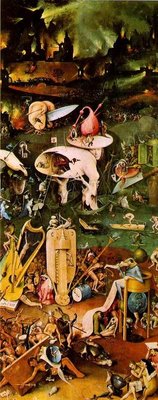
Hell, according to many religious beliefs, is a place or a state of pain and suffering.
According to many religions, the afterlife affords evildoers the opportunity to suffer eternally or repent their bad deeds before reincarnation or redemption. In monotheistic religions, hell is often populated by demons who torment the damned. The fallen angel Lucifer in christian theology, otherwise known as Satan, is considered in christian circles to be the ruler over the dominion of hell. Hell is also defined as an utter absence of God or redemptive force.
Purgatory, as believed by Catholicism, is another place of torment for sinners who have ultimately achieved salvation but have not paid penance for the sins they have committed in their former lives. Hell on the contrary is commonly believed to be for eternity with no chance of redemption or salvation for those who suffer there. Christian faith teaches it is a domain of boundless dimension, scope, and torment. Many monotheistic religions regard hell as the absolute ultimate worst-case-senario, per se.
The Greek words "Hades" and "Gehenna" are sometimes translated into the word "hell", though the concepts are dissimilar. Martin Luther, for example, translated the word "Hades" five times as the German word for "hell" (Hölle) (for example Matthew 16,18), and twice as "the dead", twice as the "world of the dead", and once as "his kingdom" (all in German). "Gehenna" was translated by Martin Luther eight times as "hell" (for example: Matthew 5,22,29,30; 18,9; Mark 9,43,45; and so on) and four times as "hellish". In Norse mythology the underworld was a cold, monotonous place, which was commanded b y the goddess Hel. The place was called Hel, too.
y the goddess Hel. The place was called Hel, too.
 y the goddess Hel. The place was called Hel, too.
y the goddess Hel. The place was called Hel, too.
Newer translations of the Bible translate "Hades" or "Sheol" into the words "world of dead", "underworld", "grave", "crypt" or similar, but still translate the word "Gehenna" into the word "hell".
Some accounts of Hell describe it as a series of numbered layers or levels. What the layers consist of differ from religion to religion, but the descriptions of certain numbered layers often coincide even between different religions. Examples of these coincidences include a layer of intense flames numbered 54 in several religions or a layer where the world looks like earth but is inhabited by demons; the soul experiencing it is never sure enough that it is in Hell to reveal their suspicion for fear of appearing insane, and is numbered 78 in at least 3 distinct religions.
No comments:
Post a Comment